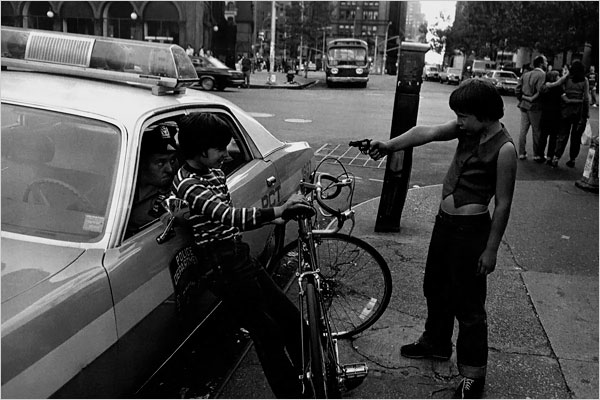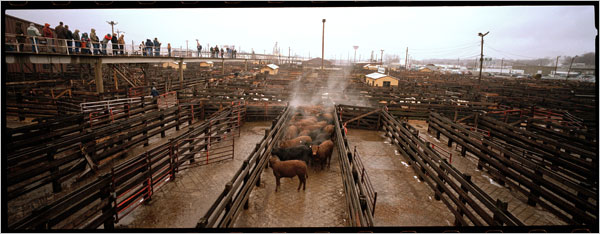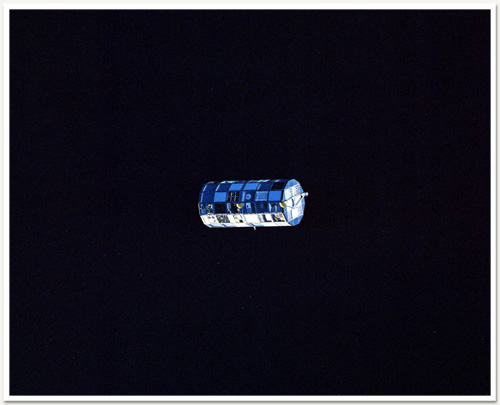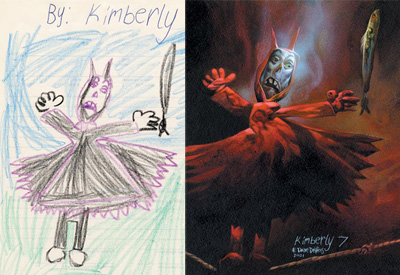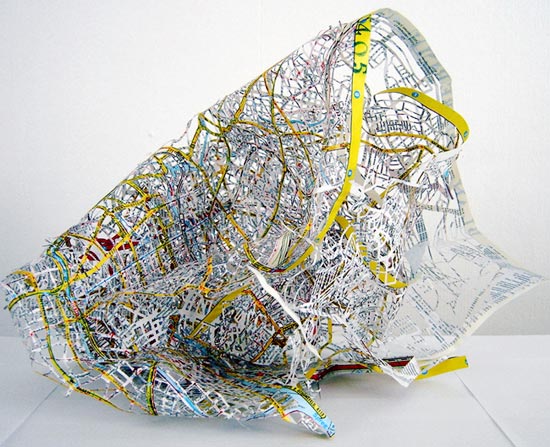Things tagged art:
Beautiful Machinery
Sculptor and engineer Arthur Ganson talks about his work -- kinetic art that explores deep philosophical ideas and is gee-whiz fun to look at.
Via Wohba!.
The World in His Mail Box: Eulogy for Tony Schwartz
Posted by Doug Schulkind to WFMU's Beware of the Blog.
Recorded sound had no greater friend than Tony Schwartz, the audio documentarian, advertising guru, media consultant, and exalted citizen of the aural universe, who passed away Saturday a few months shy of his 85th birthday. He'll be forever linked to his best-known work—the infamous "Daisy" ad from Lyndon Johnson's 1964 re-election campaign—but to many, Schwartz is beloved for sharing with the world his lifelong infatuation with the musicality of prosaic sounds.
And Doug posted some great clips from his albums, go listen.
Bizarre bouts of self-expression
Tomoko Otake for The Japan Times
Nearly 300 spectators cheered wildly as disco music blared. A spotlight picked out two fighters approaching the ring to kick off a puroresu (prowrestling) event held recently in a Tokyo town hall. Then a female MC announced, in a startlingly high-pitched voice: "In the blue corner, E.T.! In the red corner, Arm Bomb Fujiwara!" Both wrestlers were physically handicapped and had to be helped or lifted into the ring. But when the starting bell rang, the men -- both of them sitting and rolling around on the canvas -- began punching each other with all the power and accuracy they could muster.
Blows landed thick and fast, and the crowd roared. Then Arm Bomb Fujiwara got his arm round E.T.'s neck and began to throttle him. As E.T.'s face reddened to puce and he started shaking, the referee called a halt to the bout and declared a win for Arm Bomb -- who raised his fist high as the crowd laughed and shrieked.
That night, many of the dozen disabled wrestlers from the Doglegs group that staged the show in western Tokyo's Shimokitazawa district looked truly fired up and fearless. In melodramatic contrast, the few able-bodied participants were wimps, including one going by the name of "Mushikera Goro (Worthless Goro)" who, according to the program, was a hikikomori (long-term stay-at-home recluse) with a big-time Oedipus complex. He lost out to 41-year-old "Anchi-teze" (Antithesis) Kitajima, the broad-shouldered nondisabled man who is also Doglegs' leader.
But why stage contests in which one or both participants are so clearly disadvantaged? What is it all about?
"That's our intention -- to make people think," said Doglegs' leader and cofounder Kitajima -- real name, Yukinori Kitajima -- who makes a living not from running Doglegs but from writing fiction and computer-game scenarios.
Speaking after the two-hour event had ended, the father of two young girls said that over the past 15 years the group has performed around 70 times all over Japan, and once in South Korea. Then he explained: "We don't want to show something for people to simply laugh at and walk away. You might get a laugh out of our matches at times, but we also want people to wonder what this all means. We want to give people a nasty aftertaste."
See also Doglegs' homepage (Japanese), some videos on youtube.
Via NoneMoreNegative
Pencil carvings by Mizuta Tasogare and Kato Jado
Here is the artists’ page, and here is a blog post which has helpfully put most of them on one page for easy viewing.
Via Super Colossal.
Through Weegee’s Lens
Niko Koppel at The New York Times.
BACK in the 1970s, a gutsy blonde named Jill Freedman armed with a battered Leica M4 and an eye for the offbeat trained her lens on the spirited characters and gritty sidewalks of a now-extinct city.
Side note: WTF does nyt think it is doing with the video features? You can’t have your average print journalist produce a video (though they seem to do fine moving to the radio docu style as seen in the “audio slide shows”).
Werner Herzog in Conversation With Errol Morris
In The Believer is a conversation that took place at Brandeis University in the fall of 2007, moderated by Alice Arshalooys Kelikian. And this is the best conversation I have ever read:
ERROL MORRIS: Yeah. The intention is to put the audience in some kind of odd reality. [To moderator] Werner certainly shares this. It’s the perverse element in filmmaking. Werner in his “Minnesota Manifesto” starts talking about ecstatic truth. I have no idea what he’s talking about.
But what I do understand in his films is a kind of ecstatic absurdity, things that make you question the nature of reality, of the universe in which we live. We think we understand the world around us. We look at a Herzog film, and we think twice. And I always, always have revered that element. Ecstatic absurdity: it’s the confrontation with meaninglessness.
I was talking with Ron Rosenbaum, a friend of mine, who had just finished a book on Shakespeare. We were talking about the meaning of meaninglessness. Is there such a thing? And I would say: yes. Werner’s work could be considered an extended essay on the meaning of meaninglessness.
WERNER HERZOG: Thank you, yes. It feels good to hear that. [Laughter]
Later:
WH: [. . .] And I said that we were going to do a film there in Plainfield, and that really upset Errol a lot. He thought I was a thief without loot. This was his country, his territory, his Plainfield, and I shot in Plainfield. I shot a film, Stroszek, which I think is forgotten and forgiven by now, and we can maintain friendship over this now.EM: I told Werner: For you to steal a character or a story isn’t real theft. But to steal a landscape, that is a very, very serious crime.
WH: I understand that. I take it to heart, but there actually is a film out there, and we can’t take it off the map.
EM: It’s a very good film.
WH: It has a beautiful end with a dancing chicken, and I really like it.
EM: Yes.
Via cityofsound.
Trumpet Love, Part 1
Posted by Scott McDowell to WFMU's Beware of the Blog.
In the last ten years or so the trumpet has been enjoying a renaissance. There are a number of gifted and innovative trumpet players the world over deconstructing, reinventing and rethinking the instrument in myriad ways. In the '80s when John Zorn was doing mouthpiece-only duck calls and blowing his sax into a bucket of water, the trumpeters were still playing somewhat straight. I suppose it was only a matter of time. What follows is a sample of the breadth of solo trumpet sounds percolating away.
I hate "new jazz". This is not new jazz, this is some great experimental music. Be sure to check the Mazen Kerbaj as well as Peter Evans.
Christiaan Postma
The starting point with this project was a personal study about form & time. I put together more than 150 individual clockworks and made them work together to become one clock. I show the progress of time by letting the numbers be written in words by the clockworks. Reading clockwise, the time being is visible through a word and readable by the completeness of the word, 12 words from “one” to “twelve”.
Here is an animation of it in action.
Via MAKE: Blog.
After 122 Years, The Last Calf Is Sold
Beautiful "audio slide show" (need a better name for that) about the closing of the South St. Paul stockyards.
If you want more of the back-story, the news article is here.
Tokyo Metropolitan Museum of Photography
Went to the Tokyo Metropolitan Museum of Photography yesterday, and saw two of my favorite photos ever, and a contender for #3. They apparently own an amazing collection, many of my favorites were theirs.
Can't find anything by Keiichirō Gotō online, but his "Displaced History" is my new number 1. Saw a really good print of Bill Brant's "Portrait of Young Girl, Eaton Place, 1955"
The other was from Mario Giacomelli's "There are no hands to caress my face" series, a cropped to a very wide format shot of 3 seminarians compressed from background to foreground looking at a kitten climbing a tree.
The BLF brings us AT&T "In More Places"
“This campaign is an extraordinary rendition of a public-private partnership,” observed BLF spokesperson Blank DeCoverly. “These two titans of telecom have a long and intimate relationship, dating back to the age of the telegraph. In these dark days of Terrorism, that should be a comfort to every law-abiding citizen with nothing to hide.”
Via 27B Stroke 6.
JG Ballard reminisces on his boyhood years
Excerpt from Miracles of Life by JG Ballard at Times Online
I looked down from my room on the 17th floor of the Hilton and could see at a glance that there were two Shanghais – the skyscraper city newer than yesterday and at street level the old Shanghai that I had cycled around as a boy.
Via cityofsound.
Long Duration Love Affair
JMorrison at the nonist:
That cylindrical object you see pictured above is a roughly school-bus sized structure which was deployed into space in 1984. It orbited the Earth for five and a half years with nothing expected of it other than to float there, getting battered about by whatever the great black yonder saw fit to throw at it. You see, every inch of its outside surface was covered with Science. 57 separate experiments, mounted in 86 trays, involving the participation of “more than 200 principal investigators from 33 private companies, 21 universities, seven NASA centers, nine Department of Defense laboratories and eight foreign countries.” Its purpose was to study the effects of space on a multitude of materials. Its name is the Long Duration Exposure Facility (LDEF) and I am deeply in love with it.
Via cityofsound.
Digital technology is transforming photojournalism
Andrew Blum in Hard Focus (Print Mag) reproduced on his site:
Gone are the days when photojournalists lugged a chunky Rolleiflex TLR into the field and sent film home on planes. Digital technology has streamlined the process—while adding a few of its own complications. To find out more about how technology is changing photojournalism, I tracked down a few of the conflict photographers who travel around the world from hot spot to hot spot
Via cityofsound.
Children VS Artists
Jason at Rag & Bone
As a parent, I can attest to the wild imagination of children. I was a kid once too, and I remember. David Devries from South Orange New Jersey remembers too and transforms the drawings of children - with their wild imaginations for conjuring up monsters, superheros and creatures - into “adult” versions of their art.
Via Monoscope.



